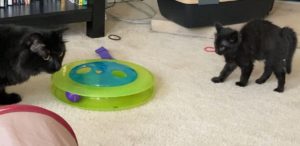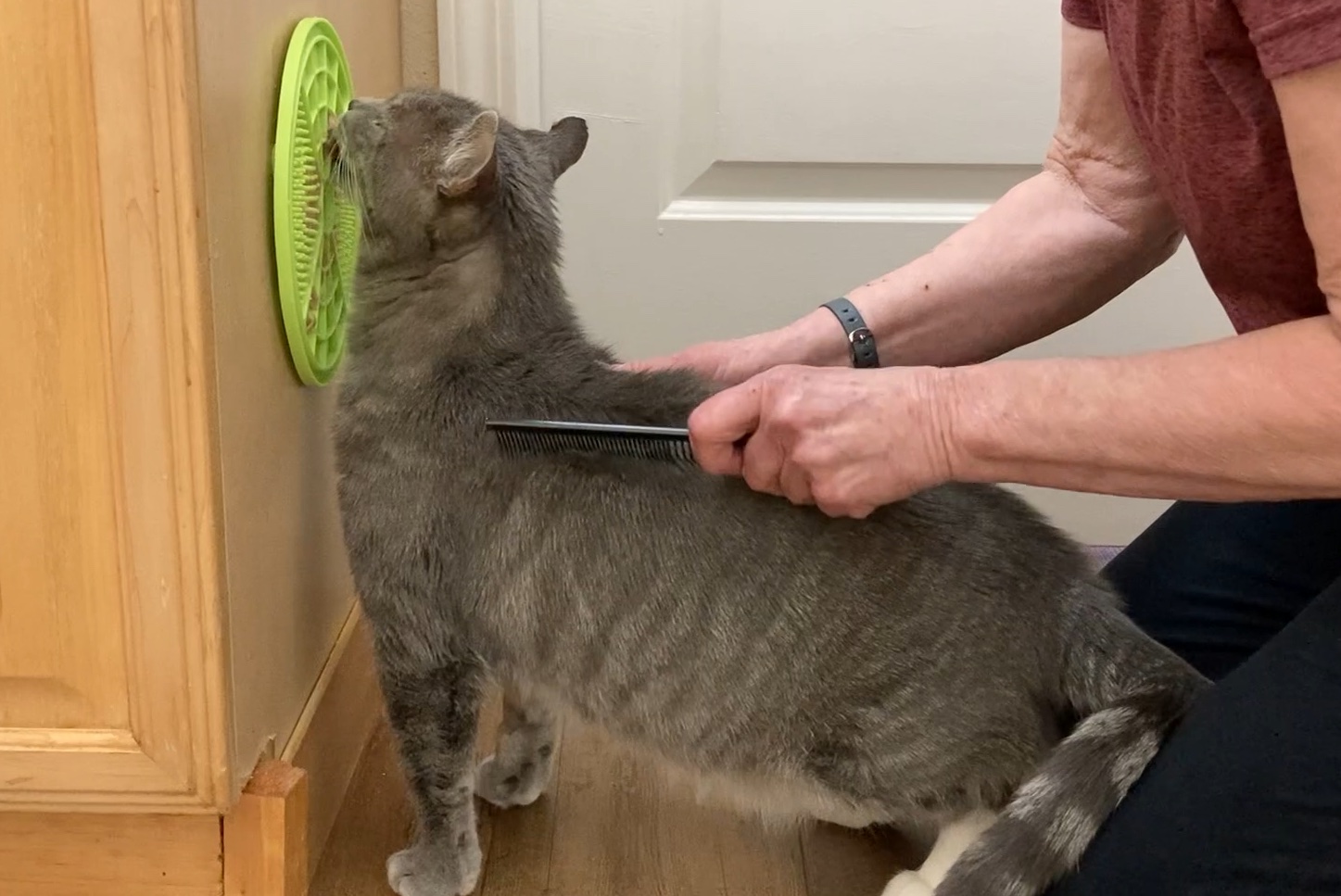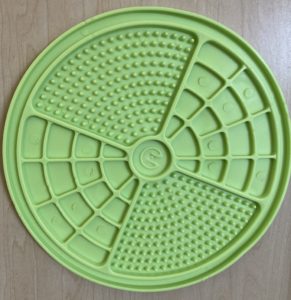 Does the color of your cat’s coat mean anything? Is there a link between coat color and temperament in cats?
Does the color of your cat’s coat mean anything? Is there a link between coat color and temperament in cats?
Black cats are often associated with the occult; orange cats tend to be regarded as friendly. Calico and tortoiseshell cats – those cats with tri-colored coats – are considered strong-willed and difficult to work with. There is even a term – “tortitude” – to describe these cats!
In a study published in 2016, researchers at UC Davis decided to look into whether there is a link between coat color and temperament – in particular, do cats with particular colors of coats tend to be more aggressive? Cat owners were recruited online to fill out a survey about their cats. The team received 1,274 responses that they analyzed with statistics.
Owners scored their cats for
- aggression toward humans
- aggression when being punished, petted, or brushed
- aggression when in the veterinary clinic
Aggression toward humans scored the frequency with which a cat reacted with aggressive or affiliative behavior to people. A 6 point scale was used ranging from 0 = never through monthly, weekly, up to 5 = daily. Behaviors included hiss, bite, slap/scratch, bite/scratch and stalk (play), groom/lick, curl up next to, approach and greet with head/body rubs. The possible range of scores was 0-20.
Aggression from handling scored the likelihood that the cat would react to being punished, petted or brushed by hissing, biting, slapping or scratching. Scores ranged from 0 = unlikely to 3 = very likely. The maximum score possible was 27. Aggression during the veterinary visit was also scored from 0 = likely to 3 = very likely but with a maximum score of 9.
Overall, the aggression scores are rather low in all three categories. For example, in the “human aggression” category, high scores were 2-3 out of 20. Female cats had higher scores overall but the research team felt the difference to be small enough that they could combine the sexes in the overall study.
Coat color and temperament – findings
Tortitude
The calico and tortoiseshell cats were found to have some of the higher scores (2.47) for aggression toward humans (Gray and white cats scored 2.26 – so not much different than the tri-color cats).
- These scores are not very high scores out of a possible 20.
- Calico/tortoiseshell cats are predominantly female (the tri-color pattern is linked to the X chromosome making the combination of 3 colors very rare in male cats). Female cats were found to be a little more aggressive than male cats in this study and this sample would have had more females.
- Perhaps, the stereotype of the “strong-willed” tri-colored female cat affected how respondents scored their cats.
other findings
- Gray and white cats, both female and male, were more aggressive toward humans and when being handled.
- Black and white male cats scored higher than other groups of male cats in human-directed aggression.
- Surprisingly, there were no significant differences in aggression among cats at the veterinary clinic.
Although the results of this study seem to support the stereotypes of cat color and aggressive behavior, e. g. “tortitude”, it is best to take these results with a grain of salt.
- Overall, the scores for aggression to humans and when being handled were quite low.
- The questionnaires were completed by the owners and there will be some differences in the way people interpret and score things.
- Stereotypes may have affected how respondents view their cats and scored them.
- The questionnaires did not involve a random sample of cats and cat owners but cat owners who voluntarily signed up to fill out the forms. These could be potentially more interested and “saavy” owners.
- There will be differences in how people approach and handle their cats.
At the Battersea Dogs and Cats home, cats were more friendly with humans after the human volunteers watched a video demonstrating how to interact with cats. ( see “Practical Guidelines for Interacting with Cats” )
The link between coat color and aggressive behavior does not seem particularly strong. Such information could be useful to cat owners, shelters, and veterinary clinics to allow them to anticipate what behaviors they may encounter. But as the saying goes, “Don’t judge a book by its cover”. A cat’s coat color is only part of the story – it is important to assess each cat as an individual. Approach him or her respectfully following the CAT guidelines.
Want to keep up with the world of cats? Subscribe to The Feline Purrspective.



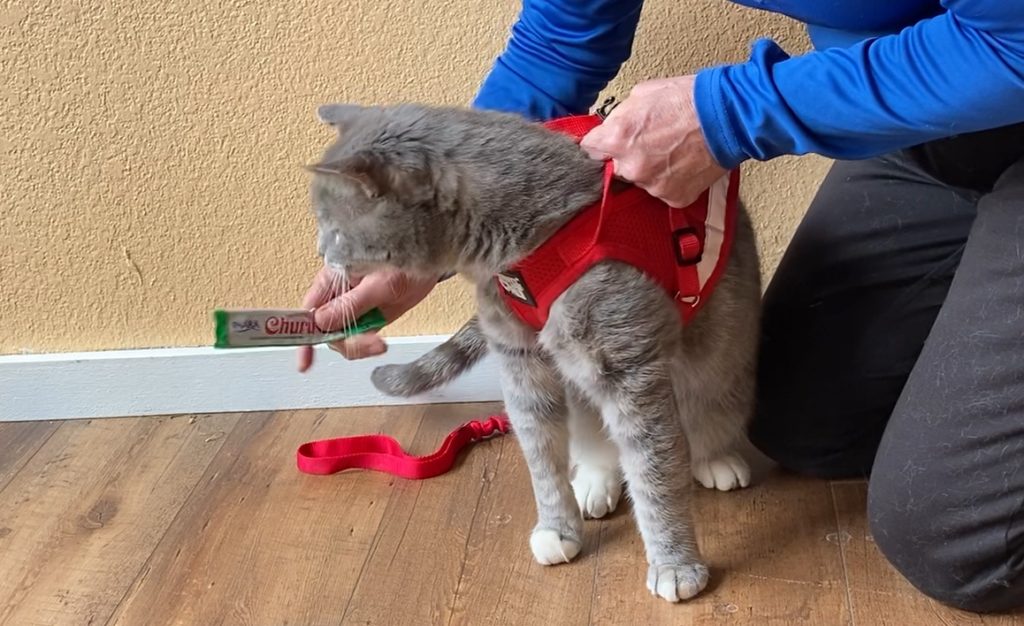



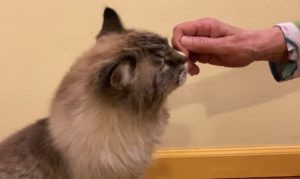 Cats live in a landscape of odors. Odors tell them about their world and its inhabitants. The signature odor or scent can play an important role when introducing a cat to something new – whether it is a another cat, dog, person or a piece of furniture.
Cats live in a landscape of odors. Odors tell them about their world and its inhabitants. The signature odor or scent can play an important role when introducing a cat to something new – whether it is a another cat, dog, person or a piece of furniture.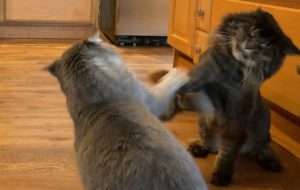 It is not uncommon for cats in a multi-cat household to engage in some redirected aggression. For example, cats waiting to be fed may engage in “boxing matches”. A cat watching birds at a window may swat at another cat who comes “too close” to her “bird-watching” spot. The cats are frustrated because the food or the birds are not available and they release their frustration through a physical motion. These incidents usually extinguish themselves and there are not lasting consequences.
It is not uncommon for cats in a multi-cat household to engage in some redirected aggression. For example, cats waiting to be fed may engage in “boxing matches”. A cat watching birds at a window may swat at another cat who comes “too close” to her “bird-watching” spot. The cats are frustrated because the food or the birds are not available and they release their frustration through a physical motion. These incidents usually extinguish themselves and there are not lasting consequences.
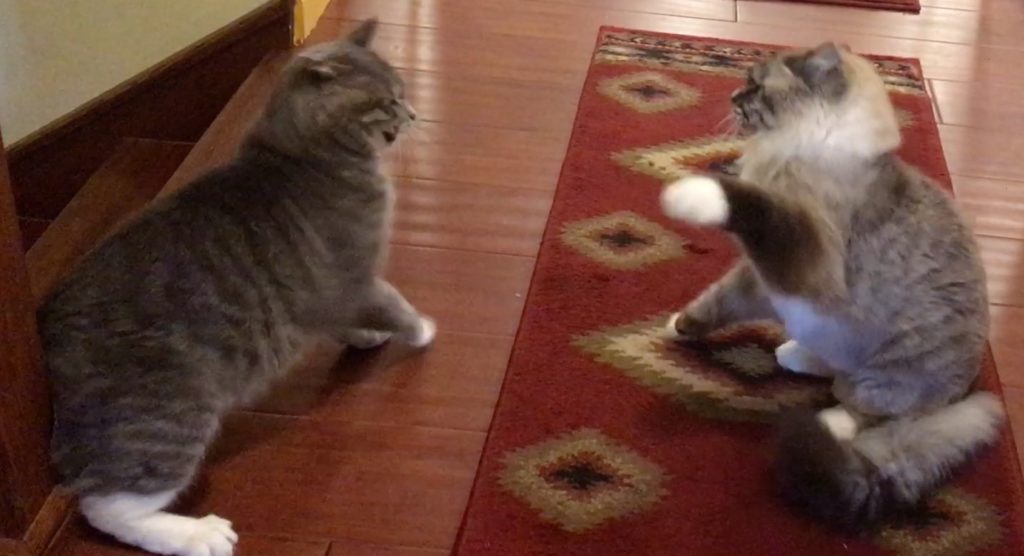 You are sitting by the window, engrossed in your latest murder mystery. You don’t notice that neighborhood tabby outside your window but your cat does and goes into full battle mode, hissing and striking at the window. You look up and jump, as your cat turns and strikes out at you. She looks like a miniature saber tooth tiger! Alarmed, you throw your glass of water at her as you beat a hasty retreat.
You are sitting by the window, engrossed in your latest murder mystery. You don’t notice that neighborhood tabby outside your window but your cat does and goes into full battle mode, hissing and striking at the window. You look up and jump, as your cat turns and strikes out at you. She looks like a miniature saber tooth tiger! Alarmed, you throw your glass of water at her as you beat a hasty retreat. Kitten kindergarten programs are great ways to continue to expose kittens to new experiences and accustom them to humans. But what if you can’t find one of these programs near you? Consider introducing your kitten to your friends and family in your own home.
Kitten kindergarten programs are great ways to continue to expose kittens to new experiences and accustom them to humans. But what if you can’t find one of these programs near you? Consider introducing your kitten to your friends and family in your own home.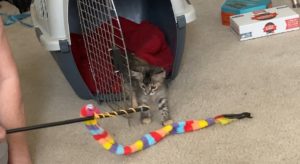 Lure your kitten out with treats or a toy. Allow her to approach people on her own – reward with a treat or play. Guests can take turns luring the kitten with toys, cuddling the kitten (if she accepts this) and offering snacks!
Lure your kitten out with treats or a toy. Allow her to approach people on her own – reward with a treat or play. Guests can take turns luring the kitten with toys, cuddling the kitten (if she accepts this) and offering snacks!